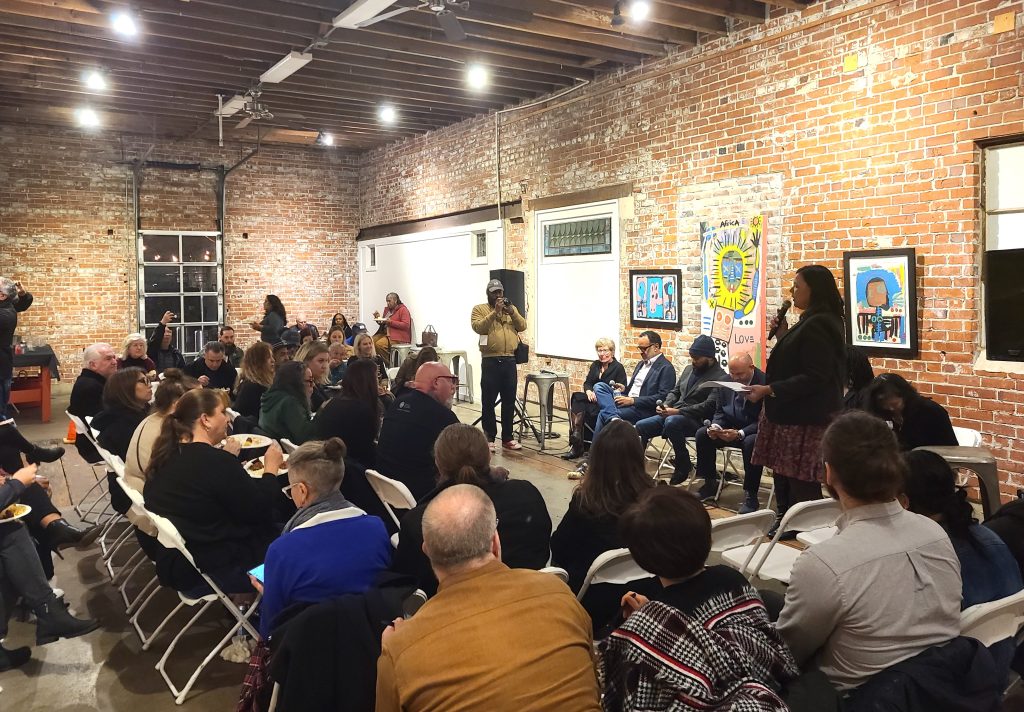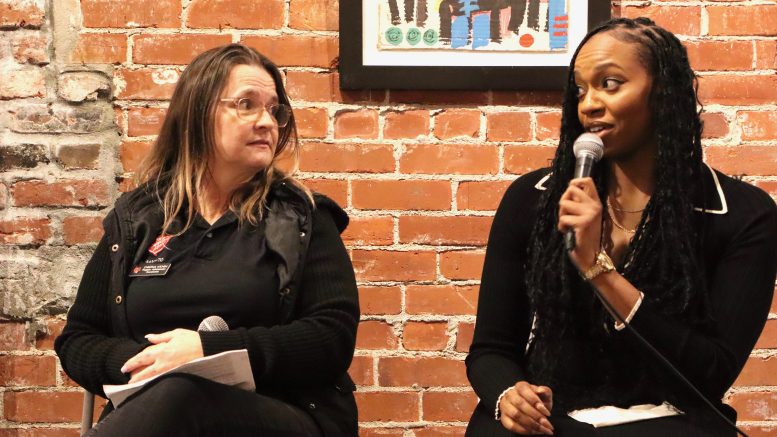While promising to boost local health care and tech economies, UC Davis’s Aggie Square project raises concerns for Oak Park community
By Keyshawn Davis
Discussions about solutions to prevent gentrification and displacement in neighborhoods surrounding UC Davis’s Aggie Square took center stage during Solving Sacramento’s Suds & Solutions (& BBQ!) event Wednesday night at The Brickhouse Gallery & Art Complex in Oak Park.
While the conversation focused on many successes that have come out of the Aggie Square project, like a Community Benefits Partnership Agreement, several speakers expressed discontent with how they feel that neighborhood groups and local residents haven’t had enough of a voice throughout the project.
The two-part discussion started with five speakers and was moderated by Robert J. Hansen, a reporter for The Sacramento Observer. Speakers from UC Davis, Wexford Science & Technology, Sacramento Community Land Trust, City of Sacramento and community advocate Michael Blair kicked off the panel to talk about the role of the CBPA in ensuring nearby communities share in the economic benefits that the university development will bring to the area.
Later, the discussion continued with representatives of organizations that got funding from the CBPA who are working on anti-displacement efforts. The CBPA is a written agreement between UC Davis, Wexford and the city. Sacramento Investment Without Displacement, a coalition of grassroots groups and other partners, worked with the city for a couple years to get the CBPA finalized.
Roughly 45 people attended the event to hear about how the CBPA is intended to promote inclusive economic development throughout the Aggie Square project, a 13-acre innovation district that could create thousands of new local tech, health care and research jobs. But while UC Davis could boost economic growth for some sectors, residents of the immediate community question if they will also benefit.
“We heard what’s going to be the economic driver for this area. And our question was for who?” said Tamika L’Ecluse, executive director of the Sacramento Community Land Trust, during the first panel. “Because we know that when new development comes in … those benefits don’t always get to the folks who are living here whose blood, sweat, tears are in this wood and the cements in the streets.”
Some of the concerns are that the innovation district could further gentrify the area, raising rent and living costs, forcing the people who have, in many cases, lived and worked in the surrounding neighborhoods for most of their lives to leave their homes and businesses.
“We really need to make sure that when they’re talking about an economic driver, when they’re talking about bringing in jobs and bringing in opportunities, it needs to be for the people who are here,” L’Ecluse stressed. “It needs to be for the people who have generations in this community and are our … impacted communities.”
L’Ecluse said she first heard about Aggie Square as president of Oak Park Neighborhood Association. She said she no longer lives in Oak Park because she couldn’t afford to buy a single-family home and looked elsewhere.
Leslie Fritzsche, the city’s economic investment manager in the office of innovation and economic development, said the CBPA takes into consideration community concerns about the development.
“It has components about youth, about transportation, community access for space, workforce and employment considerations, and a lot of components that relate to housing,” Fritzsche pointed out. “So the comment from the city is that there would be a minimum of $50 million spent for housing programs in the area around Aggie Square. So that includes Oak Park and along the Stockton Boulevard corridor. … We’ve made a commitment for a number of housing stability programs and put money into the community.”

Sumiko Hong, community engagement manager for UC Davis, told the crowd that Aggie Square started with Chancellor Gary May, who joined the university in 2017.
“Chancellor May came from Georgia Tech, where there was a very similar innovation district that had been built that brought together university researchers, and private industry and adjacent research spaces,” Hong said, adding that creating a similar innovation district was a priority for the chancellor because of how it could be an economic catalyst for the Sacramento region.
The developer chosen for Aggie Square, Wexford Science & Technology, specializes in innovation districts, said Chief Community Officer Travis Sheridan. “We only do them with universities and academic research centers,” Sheridan said, adding, “We have 17 of these Aggie Square-type things all … across the country.”
During the audience Q&A portion, Derek Barrett, executive director of People Working Together Contractor Advisory Council, asked to sit with Aggie Square decision makers and to allow him to share how his workforce training organization could be a part of the development.
“You’ll see we already have resources in place,” Barrett said. “We’re spending our own money to participate. We’re just asking for a seat at the table, to share with you some of the resources that we have, some of the available union contractors that can participate right now. All we need, again, is a seat at the table.”
Barrett said they see all of the money for development being spent citywide, and they want to be a part of it. “In order to participate, we have to be a part of the process initially,” he said. “We’re looking for work, and we have contractors ready. We need a seat at the table for decision makers to be willing to listen to our proposals and what we have to offer.”
The second part of the discussion included Leah Miller of Habitat for Humanity of Greater Sacramento, Ashley Garner of CLTRE, Sierra Edwards of Step Up and Christina Kitchen of The Salvation Army.
Much of this portion of the event focused on the achievements from the money these organizations got from the CBPA. For instance, Garner, CLTRE’s program director, spoke about how they used the funds to pilot their homebuyer program that saw 25 graduates complete the course. Garner added that programs like these are in high demand, as community members continue to inquire about CLTRE’s next homebuyer cohort.
Miller, CEO of Habitat for Humanity of Greater Sacramento, talked about how her organization has used funding from the CBPA to extend its Rock the Block campaign, which completes home repairs and property beautification projects in historically underinvested communities, according to Habitat’s website.
Rock the Block started as a 5-year project to “see the impact of home repairs over time in that 5-year period,” Miller said at the event. “But because of the funding we were able to get through the benefits agreement, we were able to further that and make a 10-year commitment.”
Throughout the evening’s conversations, many speakers reflected the sentiment that the process of the CBPA has been a learning experience — and that it can also serve as a model for other parts of Sacramento.
“It’s still going. We’re not done,” L’Ecluse said. “We need a citywide community benefits agreement that neighborhoods can negotiate and have power and have ownership of and benefit from. I think we even heard from the former council members [saying] ‘Organizations like you don’t stick around…’ . We’re all still here. We just have gray hair now.”
This story is part of the Solving Sacramento journalism collaborative. Solving Sacramento is supported by funding from the James Irvine Foundation and James B. McClatchy Foundation. Our partners include California Groundbreakers, Capital Public Radio, Outword, Russian America Media, Sacramento Business Journal, Sacramento News & Review, Sacramento Observer and Univision 19.


Be the first to comment on "Oak Park community members come together for a talk focused on anti-gentrification and displacement efforts around Aggie Square"